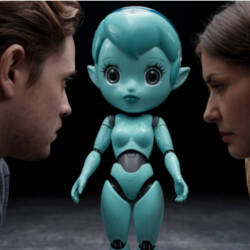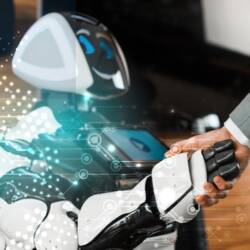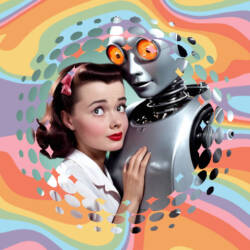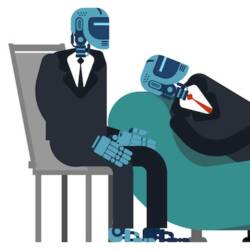Philip K. Dick’s Erotically Electric Dreams: Today’s Reality?
Will we soon be able to buy his synthetic companions wholesale?

As far as franchises go, Blade Runner is remarkably diverse. From video games to authorized follow-up novels, comic books to clothing, and even toys, it has become a huge part of popular culture
At its core, though, there are just three key works behind it all: the original novel by Philip K. Dick, its 1982 movie adaption, and Denis Villeneuve’s follow up film.
The novel that started it all

And now, in 2017—only two years away from the original film’s timeline of 2019—we’re seeing that Blade Runner isn’t just entertainment but a possible glimpse into the future of human sexuality.
Written in 1968, Philip K. Dick’s Do Androids Dream of Electric Sheep? is considered by many to be a fine, if not brilliant, story of a science-fiction master at the height of his powers. The book takes place in a near future devastated by nuclear war, where animal life is nearly extinct—save for those owned by the wealthy. Everyone else, meanwhile, has to make do with robotic creatures designed to look and act exactly like the real thing.
Trying to preserve humanity, the government encourages people to emigrate off-world to Mars. To entice Earth residents to make they move they are promised a personal replicant: an android servant that, like the animals, is practically indistinguishable from organic beings.
Our protagonist is Rick Deckard, who accepts an assignment to hunt down six rogue replicants who have returned to Earth from Mars—all so he can afford to purchase an actual, biological pet.
A new life awaits you

If this is starting sound familiar it’s because Ridley’s Scott’s 1982 film, retitled Blade Runner, does have a lot in common with the original novel by Dick. Yet while the two also have many differences, their core plot is the same: Deckard pursues rogue replicants, and in the course of doing so, deals with questions of identity, memory, and what it means to be human.
In Electric Sheep, Dick plays with one of his favorite themes: androids so realistic they can pass for human beings. In both the novel and in Scott’s film adaptation, replicants are so lifelike the only way to tell them apart from people is by using a sophisticated test that measures their reaction to emotional stimuli. (Trivia time: the questions that Deckard asks in the 1982 film are almost identical to the ones Dick uses in his original novel.)
While we may be a century or more away from being able to create anything close to a replicant, there are researchers working on giving artificial intelligence something akin to emotion.
Robots that love
As we have already reported, National Taipei University Assistant Professor Hooman Samani has been studying what he calls lovotics: the way human beings develop emotional attachments to technology. Using devices like his Mini-Surrogate, he may be on the path to making it easier to us to desire robots—and for them to have feelings for us in return.
Part of this erotic connection would require ways for robots to accurately read our emotions, which would, in turn, enable our android lovers to perfect their sexual skills thanks to loads of stored data on past encounters.
Robots that can read us

This is far from far-fetched, in fact, we’ve already seen steps in this direction like how a team from the Computer Science and Artificial Intelligence Laboratory (CSAIL) at MIT released its work on EQ-Radio: a system that uses WiFi to read a subject’s emotional state.
Right now it’s still pretty basic but give it a few more years and technology like this will be able to read not just your emotional state but maybe even your unconscious thoughts. As mentioned, more data means a much more perfect android lover.
Coincidentally, we recently explored the idea of artificial intelligence as lover in Blade Runner 2049, based on the relationship between the new Blade Runner, K (played by Ryan Gosling), and his hologram girlfriend (played Ana de Armas).
But what if you want to alter emotions, not simply have them read, perhaps as yet another way for your replicant to sexually arouse you?
The Penfield mood organ

It’s interesting that with all the iterations of Blade Runner, from comic books to toys, so few have noticed a bit of technological foresight on Dick’s part—the one that could have as much as an impact on sex as replicants.
In Electric Sheep there is something called a Penfield mood organ, a technology that Dick has used in quite a few of his books. The basic idea behind it is it is a machine that allows users to choose their emotional states. The apparatus is a way to dispel boredom and (wait for it) increase sexual desire.
It’s also an invention that’s closer than you think. Liminal VR, headed by Damian Moratti, is working on creating a device similar to Dick’s Penfield mood organ: a VR-based system that works to “combine neuroscience and design principles in virtual reality to induce a range of cognitive and emotional states, affording you the ability to control and augment your state of mind.”
We’re not sure how far Liminal VR has gone with its development but the science is certainly sound. Researchers have already established that emotions can be changed using either invasive techniques, such as with electrodes or through non-invasive means using electromagnetism.
There is even the possibility that we may be able to affect both emotion and memory, a key plot device in Electric Sheep, Ridley Scott’s 1982 Blade Runner, and even Denis Villeneuve’s sequel Blade Runner 2049.
More human than human

Putting these pieces together, it’s not hard to picture a near future where we will have android lovers that have been created to be sexually pleasurable. They may even display something very similar to human emotional reactions.
They’d know us perhaps even better than we know ourselves, being able to read our arousal and so meet our erotic needs before we can even voice them. And, if you’d like, you’ll also be able to adjust your own sexual arousal level: fine-tuning your excitement as much or as little as you want.
What this all means is what while replicants might be some years off, it looks very much like other elements in both the films as well as the original novel may arrive sooner than you think.
We can only hope that when they do, they’ll be part of a world that’s not as bleak and dystrophic as Blade Runner—in all its many forms.
Image sources: IMDB
Leave a reply
You must be logged in to post a comment.

















